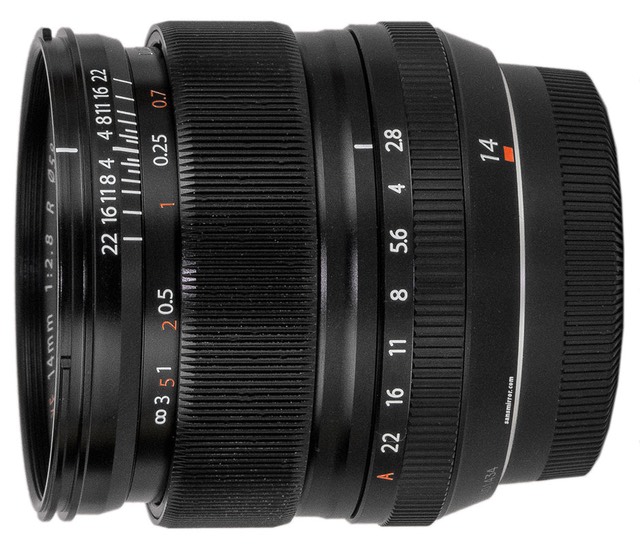
What is It?
The 14mm f/2.8 is a wide angle lens that provides about 80° horizontal coverage on the X series cameras. The 1.5x field of view change for the Fujifilm APS-based cameras means that you're getting about the same field of view as a 21mm on a full frame (35mm film sized) sensor. That's significantly wide, and we need to discuss this right up front.
As I write this, we have three "wide angle" options: 12mm (Zeiss), 14mm (the lens being reviewed), and 18mm. Those become 18mm, 21mm, and 28mm equivalents. You might notice that there's a gap in there: we have no 24mm equivalent, and many people would probably think that the best overall choice. The 14mm is wide enough that it's seriously into dramatic landscape territory, where you use the lens for a near/middle/far presentation, much like Muench and Rowell practiced. But not every user is trained at that. 14mm used incorrectly results in very flat, distant results on landscapes, so if you're going to invest in this lens for landscape use, do yourself a favor and study how to get depth into your photos with a wide angle lens.
Like all the Fujinons, there's a bit of a heft to the lens due to all the metal used in its construction. That said, there's also a lot of plastic, too. The aperture and focus rings feel a little "lightweight" to the build quality of the rest of the lens, though only a little.

From the camera side moving outwards we have:
- The standard X aperture ring, with the A position being "automatic" (and equivalent to shutter priority if you set the shutter speed on the camera, or equivalent to program if you also set the shutter dial to A).
- A reasonably wide focus ring that's not fly-by-wire, but rather directly coupled to the focus movement.
- A DOF marking set from f/4 through f/22.
The 14mm lens uses the same petal lens hood as the 18-55mm zoom, and the hood reverse bayonets on the lens to store it.
Surprisingly, the front lens element is not particularly large, and doesn't protrude past the front filter ring, which is 58mm; very modest size for a wide angle lens.
How's it Handle?
There's not a lot to say. We're back to basic prime lenses (mostly) for the X series, and with the aperture ring we're definitely in old school territory.
The aperture ring on my sample is a little loose, and has a tendency to easily move. Given that there are third-stop clicks, sometimes it can move a third of a stop without you really noticing visually, so pay attention to the camera exposure display.
To manually focus, you pull back on the focus ring towards the camera to reveal the focus marks. Focusing is then accomplished with about a quarter turn of the focus ring. That's not a lot of "throw," and worse, going from 2' to infinity is barely a small twist. Note that the feet markings are in a barely visible red on black, while the meter readings are in white. Great for the enlightened world, not so great for us stuck-in-the-middle-ages folk. Also note that you can't tweak focus when in autofocus mode (ring pushed towards front of lens).
The lens comes with a pinch-front lens cap, which is easily removed even with the lens hood on, something that's not always true these days.
Note that on an X-Pro1 with the optical viewfinder active, the 14mm is big enough to block some of the frame, especially with the lens hood on.
Over all, the 14mm is about the way you'd expect a prime lens to be: basic, mostly good characteristics, without a lot of complication.
How's it Perform?
Sharpness: As with most of the Fujinon lenses, very sharp in the central region, even wide open. The corners are soft wide open, though. By f/5.6 the lens is pretty evenly sharp corner to corner. At f/11 diffraction begins to rear its head, though the lens is still very sharp at that aperture and I wouldn't be afraid of that aperture. For a wide angle lens, the design parameters seem about right in terms of acuity. Indoors and at events, the edge softness isn't likely to be a big deal at f/2.8, and for landscapes where you want depth of field the lens behaves nicely.
Linear Distortion: There's a small degree of barrel distortion, mostly corrected in JPEGs.
Vignetting: Typical vignetting performance: worst wide open but improves to the point where you'd ignore it one stop down.
Chromatic Aberration: Decently in control across the board.
Overall: This might be one of Fujifilm's best efforts to date. Other than the corners wide open, there's really nothing to really complain about with this lens.

A really wide lens like this reveals two aspects of using a mirrorless camera like the X-E1: first, the Fujifilm sensor is good enough to simultaneously hold bright white in sunlight and deep shadow detail in complete shade. I've had to pull up the shadows a bit on this image, but there's really no noise penalty for doing that. However—and this is a big deal to me as a landscape shooter—wide lenses such as this in scenes like this one reveal just how far we need to go with the EVFs. I'm really serious about using every pixel I have, but I couldn't really see what was happening in the lower edge here while composing for two reasons: the EVF doesn't have the contrast range that lets you see into the shadows well (or, if you adjust the EVF brightness to do so, you'll lose the highlight detail), and a lens as wide as the 14mm means that very small detail just isn't seen. Like that single green leaf sticking up into the frame bottom center left. Yes, I'm that picky, and you should be two if you're buying high-end gear like this. The OVF on the X-Pro1 probably would have let me see that, but the lens would have blocked other parts of the composition.
Final Words
Curiously, we have two really wide primes now available for the Fujifilm X cameras, the 12mm Zeiss and the 14mm Fujinon. That's a bit unusual for a relatively new system, but definitely matches up well against what many people are using the X-Pro1 and X-E1 for. Neither lens is anything close to a slouch. Just the opposite, both are pretty darned good; heck, I wish I had 18mm and 21mm equivalent lenses this good back when I was shooting film.
Which one you go for is going to be partly decided by cost, partly decided by how well you handle getting close with wide angle lenses. The Zeiss is a little extreme at 12mm, and you'll be working a little harder to make great images with it, I think. For most people, the 14mm Fujinon is already enough lens, and optically it stands right up with the best wide primes I've seen.
Recommended (2012 to present)
Support this site by purchasing the lens from this advertiser:
